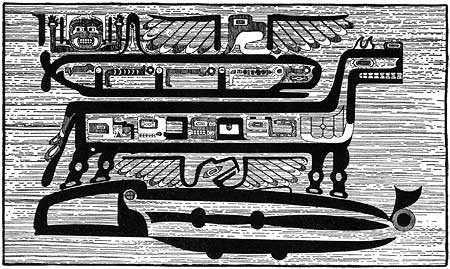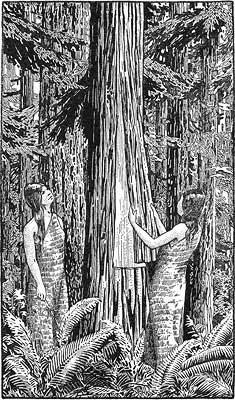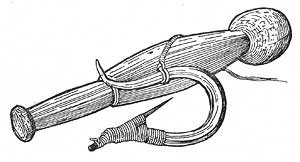How Shewish Became a Great Whale Hunter
Names Occurring in the Legend of Shewish
The Killer Whale or Ka-Kow-in has a large dorsal fin shown in a conventional manner in the pictograph between the Thunder Bird and the face of the Indian girl, sister to Shewish. The Killer Whale was often used as a family emblem or crest and as a source from which personal names were derived.Klootsmah or Kloots-a-mah plural Klootsmuk the Indian word for "married woman" but used in the legends for girls as well as women. According to Gilbert Malcolm Sproat who lived in Alberni in the early "sixties" the term used for a young girl or daughter was "Ha-quitl-is" and for an unmarried woman "Ha-quatl."
Toquaht--the home of the Toquaht tribe of Indians, an old settlement on the north shore of Barkley Sound between Ucluelet and Pipestem Inlet.
The Kutsack, or Kats-hek is a loose cloak or mantle woven from the soft inner bark of the yellow cedar tree. Indian mats were made from the inner bark of the red cedar.
 |
| Pictographic painting, the coat of arms of Shewish, Seshaht Chief. (Drawn by J. Semeyn from original sketch by the author) |
How Shewish Became a Great Whale Hunter
 |
| The bark gives way and comes in strips from off the trees. |
The daughters of the Village Island chief took with them food to last for three whole suns. They started early, for many miles of paddling lay between them and the Toquaht shore. At length they reached the beach, and hiding their canoe beneath a giant spruce, they followed where a little trail beckoned them on and up the mountain side. For hours they climbed, wending their way through lonely, silent woods, the twittering wren the only life they saw or heard. At times they lost the trail, as it was overgrown with fern and berry bush. But once the leading klootsmah stopped and signed to her companions to keep still. Halting, they waited while she pointed to the root fangs of a cedar tree, where well within the hollow butt a western timber wolf had made her lair. Gone was the mother, perhaps in quest of deer with which to feed her four young pups who calmly slept within that sheltered cave, awaiting her return.
The Indians are a superstitious race, and one of the old fetishes was this: that if by chance they could secure the young of a wolf from which to take some precious inner part, to rub upon the outer side of their canoes, it gave great luck in whaling, and thus it came to pass that when the klootsmuk found the she wolf's lair, they formed the plan of taking to their brother the four wolf pups, in order that he might become the chief of all whale hunters. Cautiously they placed them in the baskets on their backs and then retraced their steps. In time they reached the beach, and entered their canoe, when just as they pushed off, with giant springs and angry howl leapt the great mother wolf from the woods, but the klootsmuk were safe with their strange prizes, and soon their canoe cut gleefully through the waves, while their songs were wafted landward by the western breeze.
 |
| Halibut hook and club for stunning fish. |